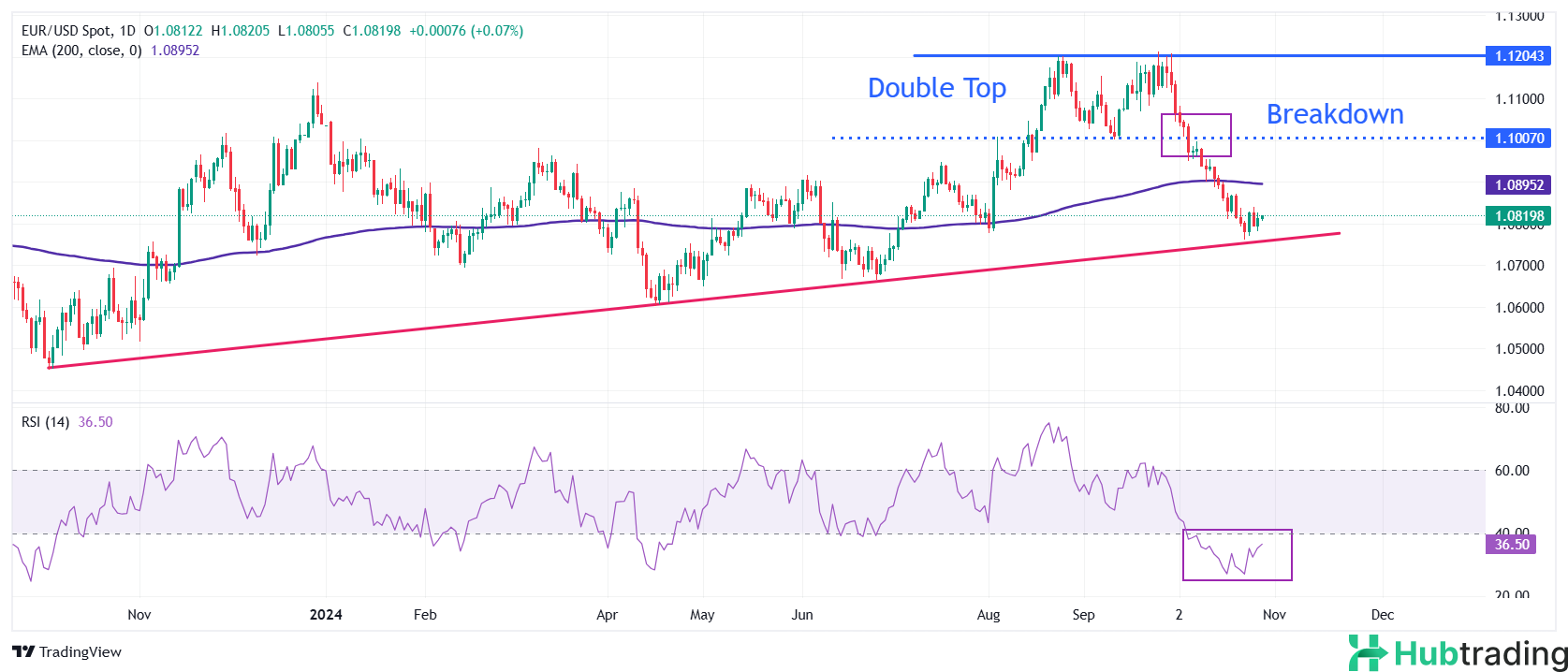- EUR/USD climbs moderately above 1.0800 as investors anticipate a range of macroeconomic data releases from the US and Eurozone this week.
- US JOLTS Job Openings are expected to show a slight decline for September.
- Traders remain uncertain about the scale of the ECB’s anticipated interest rate cut in December.
EUR/USD sees a modest rise near the 1.0800 mark in Tuesday’s European session, consolidating as the US Dollar (USD) holds gains. Investors are cautious ahead of upcoming US macroeconomic releases this week and amid growing uncertainty around the November 5 US presidential election.
Key economic data releases include the US Personal Consumption Expenditure (PCE) Price Index for September, Q3 Gross Domestic Product (GDP), October Nonfarm Payrolls, and the ISM Manufacturing Purchasing Managers’ Index (PMI). These indicators are expected to shape market views on the Federal Reserve’s (Fed) rate path for the remainder of the year.
Economists predict US job growth to have slowed in October, with only half the jobs added in September, a continued sub-50 Manufacturing PMI, slight inflation easing, and a steady annualized GDP growth of 3%. A slowdown in job creation could reinforce expectations of a Fed rate cut in December. Markets are currently pricing in a 25-basis-point (bps) reduction in borrowing costs for both November and December, according to the CME FedWatch tool.
For Tuesday’s session, focus will turn to the US JOLTS Job Openings data for September, due at 14:00 GMT. Job vacancies are forecasted to have dipped marginally from 8.04 million in August to 7.99 million in September.
Daily Digest: EUR/USD Consolidates as Investors Await US JOLTS Data
- The EUR/USD has held within a narrow range near 1.0800 over the past six sessions. The Euro (EUR) lacks clear direction as investors seek insight into the European Central Bank’s (ECB) potential rate cut in its December policy meeting.
- The ECB is expected to cut the Deposit Facility Rate, there is uncertainty over whether it will maintain its usual 25-bps pace or opt for a more aggressive reduction, as several officials have highlighted inflation risks falling short of the 2% target.
- Concerns about a possible German recession have added to inflation doubts. Investors are looking to Wednesday’s flash Q3 GDP reports for Germany and the Eurozone for further insight.
- Germany’s GDP is expected to have contracted by 0.3% year-on-year in Q3 after a flat reading in Q2, while Eurozone GDP is projected to have risen by 0.8%, up from a prior 0.6%.
- On Wednesday, the preliminary Harmonized Index of Consumer Prices (HICP) data for Germany and Spain will be released. Germany’s annual HICP is anticipated to have grown by 2.1%, while Spanish inflation is expected to stay below 2%.
Technical Analysis: EUR/USD Remains Below 200-Day EMA

EUR/USD is holding above the upward trendline near 1.0750, originating from the October 3, 2023 low of around 1.0450. The pair’s broader outlook remains bearish, however, as it trades below the 200-day Exponential Moving Average (EMA) around 1.0900.
A downside move began after a breakdown of a Double Top pattern near 1.1000 on September 11, signaling a bearish reversal. The 14-day Relative Strength Index (RSI) is ticking up but remains in the 20.00-40.00 range, suggesting further downside potential.
On the downside, a drop below 1.0750 could push EUR/USD towards the next support level at 1.0700. On the upside, resistance levels include the 200-day EMA at 1.0900 and the psychological 1.1000 barrier.





